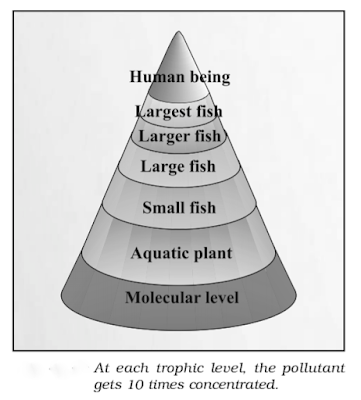Soil Pollution
Soil Pollution
India being agriculture
based economy gives high priority to agriculture, fisheries and livestock
development. The surplus production is stored by governmental and
non-governmental organization for the lean season. The food loss during the storage
also needs special attention. Have you ever seen the damages causes to the
crops, for items by insects, rodents, weeds and crop diseases etc? How can we
protect them? You are acquainted with some insecticides and pesticides for
protection of our crops. However, these insecticides, pesticides and herbicides
cause soil pollution. Hence, there is a need for their judicious use.
Pesticides
Prior to
World War II, many naturally occurring chemicals such as nicotine (by planting
tobacco plants in the crop fields), were used as pest controlling substance for
major crops in agricultural practices.
During World
War II, DDT was found to be of great use in the control of malaria and other insect-bone
diseases. Therefore, after the war, DDT was put to use in agriculture to
control the damages caused by insects, rodents, weeds and various crop
diseases. Due to adverse effects, its use has been banned in India.
Pesticides are
basically synthetic toxic chemicals with ecological repercussions. The repeated
use of the same or similar pesticides give rise to pests that are resistant to
that group of pesticides thus making the pesticides ineffective. Therefore, as
insect resistance of DDT increased, other organic toxins such as Aldrin and Dieldrin
were introduced in the market by pesticide industry. Most of the organic toxins
are water insoluble and non-biodegradable. These high persistent toxins are,
therefore, transferred from lower trophic level to higher tropic level through
food chain. Over the time, the concentration of toxins in higher animals
reaches a level which causes serious metabolic and physiological disorders.
In response
to high persistence of chlorinatd organic toxins, a new series of less
persistent or more bio-degradable products called organo-phosphates and
carbamates have been introduced in the market. But these chemicals are severe
nerve toxins and hence more harmful to humans. As a result, there are reports
of some pesticides related deaths of agricultural field workers. Insects have
become resistant to these insecticides also. The insecticide industry is
engaged in developing new groups of insecticides. But one has to think, is this
only solution to pest menace?
These days, the
pesticide industry has shifted its attention to herbicides such as sodium chlorite
(NaClO3), sodium arsinite (Na3AsO3) and many
others. During the first half of the last century, the shift from mechanical to
chemical weed control had provided the industry with flourishing economic
market. But one must remember that these are also not environment friendly.
Most herbicides
are toxic to mammals but are not as persistent as organo-chlorides. These chemicals
decompose in a few months. Like organo-chlorides, these too become concentrated
in the food web. Some herbicides cause birth defects. Studies show that
cornfields sprayed with herbicides are more prone to insect attack and plant
disease than fields that are weeded manually.
Pesticides and
herbicides represent only a very small portion of widespread chemical pollution.
A large number of other compounds that are used regularly in chemical and
industrial processes for manufacturing activities are finally released in the
atmosphere in one or other form.
Industrial Waste
Industrial solid
wastes are also sorted out as biodegradable and non-degradable wastes. Biodegradable
wastes are generated by cotton mills, food processing units, paper mills and
textile factories.
Non-biodegradable
wastes are generated by thermal power plans which produce fly ash; integrated iron
and steel plants which produce blast furnace slag and steel melting slag. Industries
manufacturing aluminum zinc and copper produce mud and tailings. Fertilizer industries
produce gypsum. Hazardous wastes such as inflammables, composite explosives or
highly reactive substances are produced by industries dealing in metals,
chemicals, drugs, pharmaceuticals, dyes, pesticides, rubber goods etc.
The disposal of non-degradable industrial solid
wastes, if not done by a proper and suitable method, if not done by a proper
and suitable method, may cause serious threat to the environment. Now innovations
have led to different uses of waste material. Nowadays, fly ash and slag from
the steel industry are utilized by the cement industry. Large quantities of
toxic wastes are usually destroyed by controlled incineration, whereas small
quantities are burnt along with factory garbage in open bins. Moreover, solid
wastes if not managed effectively, affect the components of the environment.

Chemical herbicides are effective and relatively low cost. On the other hand, they involve using potentially harmful substances in your own backyard. herbicides for blackberries in this comparison of top products
ReplyDelete